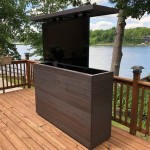Understanding Outdoor Lamp Post Motion Sensor Technology
Outdoor lamp post motion sensors represent a significant advancement in residential and commercial lighting solutions. These devices combine the traditional functionality of a lamp post with the energy-saving and security benefits of motion-activated lighting. By illuminating areas only when movement is detected, they offer a practical approach to reducing energy consumption, enhancing security, and providing convenient illumination.
The integration of motion sensor technology into outdoor lamp posts expands their utility beyond simple illumination. They become proactive security measures, deterring potential intruders and alerting residents to activity around their property. Furthermore, the automatic nature of motion-activated lighting eliminates the need for manual operation, offering convenience and ease of use.
This article will explore the various aspects of outdoor lamp post motion sensors, including their functionality, benefits, installation considerations, and factors to consider when selecting the appropriate model. It aims to provide a comprehensive understanding of this technology for homeowners, business owners, and anyone seeking to enhance their outdoor lighting with smart and efficient solutions.
How Outdoor Lamp Post Motion Sensors Work
At the core of an outdoor lamp post motion sensor is the motion detection technology itself. The most common type used in these devices is Passive Infrared (PIR) technology. PIR sensors detect changes in infrared radiation, which is naturally emitted by objects, including humans, animals, and vehicles. When an object with a different temperature than the surrounding environment moves within the sensor’s field of view, the PIR sensor detects this change and triggers the lamp post to illuminate.
The PIR sensor consists of two pyroelectric sensors that are sensitive to infrared radiation. These sensors are positioned side-by-side and react to changes in infrared levels rather than absolute levels. This configuration helps to minimize false alarms caused by gradual changes in ambient temperature, such as those resulting from changes in weather or sunlight.
The motion sensor is usually integrated into the lamp post fixture, either discreetly within the lamp head or in a separate housing mounted on the pole. The sensor’s field of view, or detection range, is a crucial factor in its effectiveness. Manufacturers typically specify the detection range in terms of both distance and angle, allowing users to understand the area covered by the sensor. This range can often be adjusted to suit specific needs and prevent triggering from unwanted sources, such as passing traffic on a nearby street.
Upon detecting motion, the sensor sends a signal to the lamp post's lighting system, activating the light. The duration for which the light remains illuminated after motion is no longer detected is also typically adjustable. This "on-time" setting allows users to customize the system's response to their individual preferences and needs, balancing energy efficiency with adequate illumination time.
Some advanced models incorporate additional features such as daylight sensors. These sensors prevent the motion sensor from activating the light during daylight hours, further enhancing energy efficiency. The daylight sensor measures the ambient light level and disables the motion sensor when sufficient natural light is available. This ensures that the lamp post only activates when it is needed, conserving energy and extending the lifespan of the light source.
Benefits of Using Outdoor Lamp Post Motion Sensors
The benefits of integrating motion sensor technology into outdoor lamp posts are multifaceted, encompassing energy savings, enhanced security, increased convenience, and improved safety.
Energy Savings: This is arguably the most significant advantage. By illuminating the area only when motion is detected, the system significantly reduces energy consumption compared to traditional lamp posts that remain on continuously. The extent of energy savings depends on the frequency of activation and the type of light source used. LED lighting, in particular, combined with motion sensor technology, offers substantial energy savings due to the low power consumption of LEDs and the infrequent activation of the light.
Enhanced Security: A sudden burst of light can deter potential intruders. When a motion sensor detects movement, the immediate illumination can startle individuals who may be attempting to trespass or engage in other illicit activities. The increased visibility also allows residents or security personnel to identify potential threats more easily. This proactive security measure can contribute to a safer environment and provide peace of mind.
Increased Convenience: Motion-activated lamp posts eliminate the need to manually switch lights on and off. This is particularly beneficial in areas where manual operation is inconvenient or impractical, such as near driveways, walkways, or backyards. The automatic illumination provides hands-free lighting as needed, enhancing convenience for residents and visitors alike. This automatic functionality is especially helpful when carrying groceries, entering or exiting vehicles, or navigating pathways at night.
Improved Safety: Motion-activated lighting can improve safety by illuminating potential hazards, such as steps, uneven surfaces, or obstacles. This is particularly important in areas with poor visibility, where accidents are more likely to occur. The sudden illumination provides immediate visibility, allowing individuals to navigate safely and avoid potential injuries. This safety aspect is especially valuable for elderly individuals, those with mobility limitations, and children.
Extended Bulb Life: Because the light is only on when needed, the lifespan of the light bulb is extended compared to continuously illuminated fixtures. This reduces the frequency of bulb replacements, saving both time and money. This is particularly advantageous when using long-lasting LED bulbs, which can last for several years with intermittent use.
Factors to Consider When Selecting an Outdoor Lamp Post Motion Sensor
Choosing the right outdoor lamp post motion sensor requires careful consideration of several factors to ensure optimal performance and satisfaction. These factors include sensor range and sensitivity, light source type, weather resistance, design and aesthetics, and installation requirements.
Sensor Range and Sensitivity: The sensor's range and sensitivity are critical for effective motion detection. The range determines the area covered by the sensor, while the sensitivity determines how readily it detects motion. It is important to choose a sensor with a range that is appropriate for the intended application. A longer range may be necessary for larger properties, while a shorter range may be sufficient for smaller areas. The sensitivity should be adjustable to minimize false alarms caused by small animals or other non-threatening movements. Consider the environment where the lamp post will be installed and adjust the sensitivity accordingly to achieve the desired balance between detection and false alarms.
Light Source Type: The type of light source used in the lamp post significantly impacts its energy efficiency and illumination quality. Options include incandescent, halogen, compact fluorescent (CFL), and light-emitting diode (LED) bulbs. LEDs are generally the preferred choice due to their energy efficiency, long lifespan, and instant-on capability. They also produce a bright, clear light that enhances visibility. Although initially more expensive, LEDs offer significant long-term cost savings due to their reduced energy consumption and infrequent replacement requirements. Consider the color temperature of the light source as well, as this can affect the ambiance and visibility of the illuminated area. Warmer color temperatures (around 2700K) provide a softer, more inviting light, while cooler color temperatures (around 5000K) offer a brighter, more focused light.
Weather Resistance: Outdoor lamp posts are exposed to the elements, so weather resistance is essential. Choose a lamp post and motion sensor that are designed to withstand rain, snow, wind, and temperature fluctuations. Look for products with a high Ingress Protection (IP) rating, which indicates the level of protection against dust and water ingress. An IP rating of IP44 or higher is generally recommended for outdoor use. The housing material should also be durable and corrosion-resistant to ensure long-lasting performance in harsh weather conditions.
Design and Aesthetics: The lamp post should complement the architectural style of the property. Consider the design, finish, and overall appearance of the lamp post to ensure it blends seamlessly with the surrounding landscape. Options range from traditional and ornate designs to modern and minimalist styles. Choose a lamp post that enhances the visual appeal of the property while providing functional lighting. Pay attention to details such as the shape of the lamp head, the finish of the pole, and the overall proportions of the fixture.
Installation Requirements: Consider the installation requirements before purchasing a lamp post motion sensor. Some models may require professional installation, while others can be installed by homeowners with basic electrical knowledge. Ensure that the chosen location is accessible for wiring and that the electrical capacity is sufficient to support the lamp post. If professional installation is required, factor in the cost of labor when budgeting for the project. Also, check local building codes and regulations to ensure compliance with any applicable requirements. Some municipalities may have restrictions on outdoor lighting, such as limitations on brightness or regulations regarding light trespass.
Adjustability: Opt for a model with adjustable settings for sensitivity, range, and on-time. This allows for customization to suit specific needs and preferences. Being able to fine-tune the sensor's parameters can prevent false alarms and optimize energy efficiency. Adjustable sensitivity allows for tweaking the sensor's response to different types of motion, while adjustable range allows for focusing the detection area. Adjustable on-time allows for controlling how long the light remains illuminated after motion is no longer detected, balancing convenience with energy conservation.
By carefully considering these factors, individuals can select an outdoor lamp post motion sensor that meets their specific needs, provides reliable performance, and enhances the safety and security of their property.

Solar Gate Post Light With Pir Motion Sensor Solamon Led Range

Dusk To Dawn Motion Sensor Outdoor Post Lights Exterior Lamp Light Ebay

Leton 4 3 High Motion Sensor Post Light Adaptor 3j871 Lamps Plus Lights Outdoor

Motion Sensor Post Lighting At Lowes Com

Victorian Lantern Lamp Post Pir Motion Sensor Fitment

Contemporary Wall Light Smart Post Rab Lighting Indoor Outdoor Metal

Single Head Led Post Light W Motion Sensor 4w In Black Curved Straig The Lighting Outlet

Historical Garden Light With Motion Sensor Place Des Vosges 1 Terra Lumi

Adding Motion Detector To A Lamp Post Doityourself Com Community Forums

1 Light Matte Black Motion Sensing Dusk To Dawn Outdoor Post Lantern W Cattleyalighting
See Also








